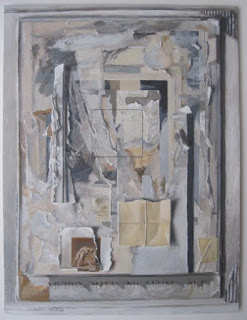'Agnes Martin' at The Tate Gallery ends on October the 11th 2015.
Struck initially by the similarity between the strong but understated abstract expressionist grid paintings of Agnes Martin and the regular patterns of brickwork that are such an integral part of both the emotional and built environment in Bruges I found her recently published biography, 'Agnes Martin: Her Life and Art' by Nancy Princenthal in the Raaklijn bookshop. Her practical interest in Zen Buddhism and Asian philosophy is clearly present in her statements about getting rid of intellectual 'ideas' and being 'empty' to respond to pure emotional inspiration not as an expression of personal ego.
Struck initially by the similarity between the strong but understated abstract expressionist grid paintings of Agnes Martin and the regular patterns of brickwork that are such an integral part of both the emotional and built environment in Bruges I found her recently published biography, 'Agnes Martin: Her Life and Art' by Nancy Princenthal in the Raaklijn bookshop. Her practical interest in Zen Buddhism and Asian philosophy is clearly present in her statements about getting rid of intellectual 'ideas' and being 'empty' to respond to pure emotional inspiration not as an expression of personal ego.
After leaving New York she appeared to renounce the comfort and security of more conventional artists, painting 'with her back to the world' and living a largely spartan solitary life in an adobe house she built herself in New Mexico. She abandoned painting for seven years but this period of transition, along with her closeted homosexuality and periods of mental turbulence were also perhaps important springs of independence and inspiration - her 'voices'. Later in life she enjoyed considerable success, fame and cult status ironically perhaps given her self-effacing self-imposed reclusive lifestyle.
'The beauty is not in the rose the beauty is in your mind'
The context for this statement can be found in the link below.
Tate Shots: Agness Martin
'The beauty is not in the rose the beauty is in your mind'
The context for this statement can be found in the link below.
Tate Shots: Agness Martin
 |
| Agnes Martin, Friendship, 1963, incised gold leaf and gesso on canvas. |
Still working on a series of black and
white paintings for F which keep changing as further layers 'subtract'
earlier layers by a process of 'addition'. This is their current status below.
Agnes Martin felt that music was the best and highest form of art because it was completely abstract and drew a powerful emotional response from the listener.
During the summer I was able to hear three concerts which formed part of the MA festival of early music in Bruges. The Vox Luminis ensemble's perfomance of Giacomo Carissimi's counter reformation oratorio Jepthte and Vanitas Vanitatum alongside compositions by Luigi Rossi, Domenico Mazzocchi and Kaspar Förster at the Sint Jakobskerk was the most moving and powerful for me. The others MEDIA VITA Stile Antico at the Sint Walburgakerk and IL TRIONFO DEL TEMPO E DEL DISINGANNO by G.F. Handel with Dunedin Consort ensemble at the concertgebouw which presented an allegorical
duel between vanity and transience.









No comments:
Post a Comment